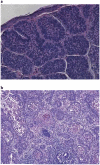Basal cell carcinomas: attack of the hedgehog
- PMID: 18813320
- PMCID: PMC4457317
- DOI: 10.1038/nrc2503
Basal cell carcinomas: attack of the hedgehog
Abstract
Basal cell carcinomas (BCCs) were essentially a molecular 'black box' until some 12 years ago, when identification of a genetic flaw in a rare subset of patients who have a great propensity to develop BCCs pointed to aberrant Hedgehog signalling as the pivotal defect leading to formation of these tumours. This discovery has facilitated a remarkable increase in our understanding of BCC carcinogenesis and has highlighted the carcinogenic role of this developmental pathway when aberrantly activated in adulthood. Importantly, a phase 1 first-in-human trial of a Hedgehog inhibitor has shown real progress in halting and even reversing the growth of these tumours.
Figures



References
-
- Miller DL. Nonmelanoma skin cancer in the United States: incidence. J. Am. Acad. Dermatol. 1994;30:774–778. - PubMed
-
- Housman TS, et al. Skin cancer is among the most costly of all cancers to treat for the Medicare population. J. Am. Acad. Dermatol. 2003:425–429. - PubMed
-
- Rubin AI, Chen EH, Ratner D, carcinoma Basal-cell. N. Eng. J. Med. 2005;353:2262–2269. This paper gives an authoritative, more complete review of the more clinical aspects of this tumour. - PubMed
-
- Karagas MR, et al. Use of tanning devices and risk of basal cell and squamous cell skin cancers. J. Natl Cancer Inst. 2002:224–226. - PubMed
-
- Marcil I, Stern RS. Risk of developing a subsequent nonmelanoma skin cancer in patients with a history of nonmelanoma skin cancer: a critical review of the literature and meta-analysis. Arch. Dermatol. 2000;136:1524–1530. - PubMed
Publication types
MeSH terms
Substances
Grants and funding
LinkOut - more resources
Full Text Sources
Other Literature Sources
Medical

